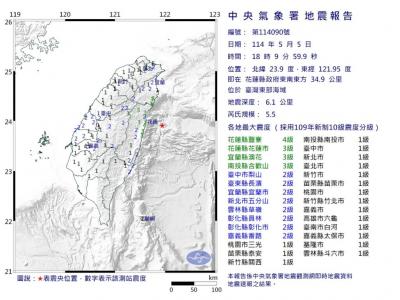The lack of US intelligence on a new type of short-range ballistic missile allegedly deployed by China has led some defense specialists to conclude that the projectile could be a medium-range missile already known to US authorities.
Debate over the existence of the Dong Feng-16 (DF-16) emerged soon after National Security Bureau (NSB) Director Tsai Der-sheng (蔡得勝) informed the legislature on March 16 that his agency had intelligence proving that the People’s Liberation Army (PLA) had finished testing and had deployed a new type of missile. In his testimony, Tsai said that some of the missiles, with a range of between 800km and 1,000km, were targeting Taiwan.
The faster re-entry of a longer-range ballistic missile, experts said, would make it more difficult for interceptors, such as Taiwan’s PAC-3, to defend against them.
With scant specific references in the literature and no confirmation from other intelligence agencies, some experts have wondered whether Tsai’s DF-16 might not be a variant of an existing short-range ballistic missile (SRBM), such as the DF-11 or DF-15, of which more than 1,000 are targeted at Taiwan.
However, some defense specialists approached by the Taipei Times said that as older SRBMs had been developed in the 1980s and fielded in the 1990s, it would not be surprising, as per industrial cycles, for an altogether new type of missile to be developed.
While variants of a missile are indicative of minor design improvements — for example, the DF-15C, which some reports say could serve as a longer-range upgrade at the Second Artillery’s Leping SRBM Brigade in Jiangxi Province — new designations, such as the DF-16, imply fundamental design changes, such as advances in solid rocket fuel, guidance systems and warhead design.
However, the lack of specifics provided by Tsai, who claimed Taiwan had sources unavailable to its allies, has led some analysts to conclude that rather than a brand new type of SRBM, the DF-16 could in fact be a medium-range ballistic missile (MRBM) already known to US intelligence, the CSS-X-11.
A spokesperson for the NSB would not comment on the matter when contacted by the Taipei Times yesterday.
That view was reinforced by comments by an unnamed military intelligence official, also on March 16, to the effect that the new missile could have a range of between 1,000km and 1,500km, making it, according to the US definition, a MRBM rather than a SRBM.
A week prior to Tsai’s announcement, an article in the Washington Times said the US intelligence community had assessed that on Jan. 11 last year, the PLA had successfully intercepted a CSS-X-11 MRBM launched from the Shuangchengzi Space and Missile Center in Gansu Province using a SC-19 anti-satellite missile. The story, based on a US Department of State cable made public by WikiLeaks, said that while little was known about the CSS-X-11, it could be an extended-range variant of the CSS-7 (DF-11) short-range missile.
US missile warning satellites had detected the launches and the intercept at an altitude of about 250km, the report said.
An intercept at an altitude of 250km would confirm that the ballistic missile had a range of at least 1,000km.
The “X” in CSS-X-11 means the missile was still in development at the time of the report, meaning that if the MRBM has since been deployed, it would be known as the CSS-11.
The last US Department of Defense report to Congress, which covered events through December 2009, made no mention of the CSS-11.
According to Roger Cliff, an independent military expert, the DF-16 and CSS-11 could therefore be one and the same, as it is unlikely “US analysts would be unaware of the deployment of a new type of missile.”
“If anything new [such as the DF-16] is test-fired, DSP [Defense Support Program] and SBIRS [Space Based Infrared System] satellites will pick it up and be able to calculate its trajectory [and range],” Cliff said.
Equally improbable was that China would have two new MRBMs in development simultaneously, Cliff said.
However, not all experts were convinced that this was the case.
Rick Fisher, a senior fellow at the International Assessment and Strategy Center in Washington, did not agree that it would not make sense to have more than one missile program.
“Why wouldn’t China have two MRBM programs?” he told the Taipei Times yesterday. “It has two distinct tactical missile design and production teams producing two families of formal SRBMs. These teams have also started producing competing SRBMs, the 150km range P-12 and the 360km range B-611M.”
“The PLA values redundancy, as we see it in many other weapons system families. Redundancy fosters competition and thus faster technology breakthrough and development timelines, to achieve a far more rapid military buildup,” Fisher said. “That one SRBM design/production team may be building up to a competing MRBM line does not strike me as improbable or odd, but consistent.”

An essay competition jointly organized by a local writing society and a publisher affiliated with the Chinese Communist Party (CCP) might have contravened the Act Governing Relations Between the People of the Taiwan Area and the Mainland Area (臺灣地區與大陸地區人民關係條例), the Mainland Affairs Council (MAC) said on Thursday. “In this case, the partner organization is clearly an agency under the CCP’s Fujian Provincial Committee,” MAC Deputy Minister and spokesperson Liang Wen-chieh (梁文傑) said at a news briefing in Taipei. “It also involves bringing Taiwanese students to China with all-expenses-paid arrangements to attend award ceremonies and camps,” Liang said. Those two “characteristics” are typically sufficient

A magnitude 5.9 earthquake that struck about 33km off the coast of Hualien City was the "main shock" in a series of quakes in the area, with aftershocks expected over the next three days, the Central Weather Administration (CWA) said yesterday. Prior to the magnitude 5.9 quake shaking most of Taiwan at 6:53pm yesterday, six other earthquakes stronger than a magnitude of 4, starting with a magnitude 5.5 quake at 6:09pm, occurred in the area. CWA Seismological Center Director Wu Chien-fu (吳健富) confirmed that the quakes were all part of the same series and that the magnitude 5.5 temblor was

The brilliant blue waters, thick foliage and bucolic atmosphere on this seemingly idyllic archipelago deep in the Pacific Ocean belie the key role it now plays in a titanic geopolitical struggle. Palau is again on the front line as China, and the US and its allies prepare their forces in an intensifying contest for control over the Asia-Pacific region. The democratic nation of just 17,000 people hosts US-controlled airstrips and soon-to-be-completed radar installations that the US military describes as “critical” to monitoring vast swathes of water and airspace. It is also a key piece of the second island chain, a string of

The Central Weather Administration has issued a heat alert for southeastern Taiwan, warning of temperatures as high as 36°C today, while alerting some coastal areas of strong winds later in the day. Kaohsiung’s Neimen District (內門) and Pingtung County’s Neipu Township (內埔) are under an orange heat alert, which warns of temperatures as high as 36°C for three consecutive days, the CWA said, citing southwest winds. The heat would also extend to Tainan’s Nansi (楠西) and Yujing (玉井) districts, as well as Pingtung’s Gaoshu (高樹), Yanpu (鹽埔) and Majia (瑪家) townships, it said, forecasting highs of up to 36°C in those areas